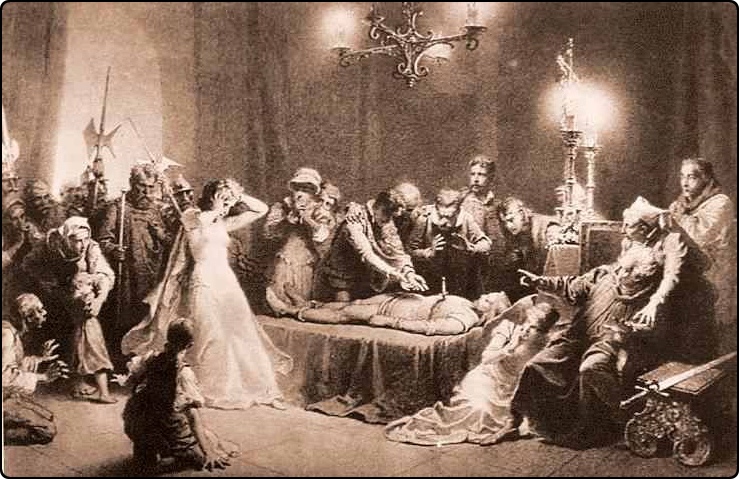Trial By Touch

Back in colonial times, the American legal system occasionally relied upon a curious form of murder investigation known as "Trial by Touch." The book Legal Executions in New England: A Comprehensive Reference offers this explanation:
It was widely believed in those days that "murdered blood cried for vengeance" just as the blood of Abel was said to have "cried up from the ground." This formed the rationale for a further belief that if a murderer touched the corpse of his victim, that corpse would either bleed or have the "blood come fresh upon it."
That same book offers a number of examples of people found guilty by means of the Trial by Touch. For instance, in 1644 Goodwife Cornish of York, Maine, was accused of killing her husband, whose body was found floating in the York River:
Goodwife Cornish and Edward Johnson [her supposed lover] were both confronted with the decomposed remains of Richard Cornish and compelled to put their hands thereon. As they did so, blood oozed from the dead man's wounds.
Both of the accused were next brought before a council of local officials. The ensuing "trial" was a farce. The prosecution's only evidence was the result of the "Trial by Touch" and hearsay about the woman's character. It was her reputation more than anything else that counted against Goodwife Cornish. She was declared guilty and condemned to death. Edward Johnson was acquitted.
During her "trial" Goodwife Cornish continued to deny all knowledge of the murder. She repeated her admissions of lewd conduct and even named a local official as one of her lovers. Few doubted the story because the man had a reputation of his own. Goodwife Cornish was hanged at York in December of 1644. There the matter ended.
Both of the accused were next brought before a council of local officials. The ensuing "trial" was a farce. The prosecution's only evidence was the result of the "Trial by Touch" and hearsay about the woman's character. It was her reputation more than anything else that counted against Goodwife Cornish. She was declared guilty and condemned to death. Edward Johnson was acquitted.
During her "trial" Goodwife Cornish continued to deny all knowledge of the murder. She repeated her admissions of lewd conduct and even named a local official as one of her lovers. Few doubted the story because the man had a reputation of his own. Goodwife Cornish was hanged at York in December of 1644. There the matter ended.
Trial by Touch was referred to by a number of different names, such as "Ordeal by Touch" or "Ordeal of the Bier." The Penny Magazine (January 1842) explains this latter name:
The murdered person was placed upon a bier, and the suspected assassin desired to approach and touch the corpse. If blood flowed from the wounds, or the position of the body became changed, the charge of murder was considered as proven. The ordeal of the bier was in frequent use in the sixteenth century, and was even resorted to on one occasion at the commencement of the eighteenth.
I haven't found much info in academic sources about the Trial by Touch. Evidently the custom was widely practiced throughout Europe during the Middle Ages and then brought to America by settlers. And apparently a bleeding corpse wasn't the only indicator of guilt. If the corpse seemed to change color, sweat, or move at all, that would be enough to convict the accused. In The Old Farmer and His Almanack (1920), GL Kittredge offers the example of the trial of Johan Norkott in England (1628):
On this occasion the minister of the parish, "a very reverend person," testified (and his evidence was corroborated) that when the body was touched by the defendants thirty days after death, "the brow of the dead, which before was of a livid and carrion colour, begun to have a dew or gentle sweat arise on it, which increased by degrees, till the sweat ran down in drops on the face. The brow turned to a lively and fresh colour and the deceased opened one of her eyes and shut it again: And this opening the eye was done three several times. She likewise thrust out the ring or marriage finger three times, and pulled it in again; and the finger dropped blood from it on the grass."
The illustration at the top is by the Hungarian artist Mihály Zichy (1894). It depicts a scene from a ballad about a woman found guilty, by means of the Ordeal by Touch, of killing her young husband (via Hungarian Art History).
Comments
So if you refused to touch the body were you automatically found guilty because of your refusal?
Posted by GFinKS on 08/01/16 at 02:52 PM
Commenting is not available in this channel entry.

Category: Crime | Customs | Death